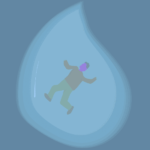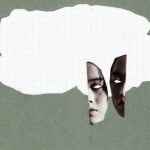
Nothing is worse to me than waking up in the middle of the night, in some hour so far from dawn that even a city street is hushed. When the sound of my name called me to a dark ceiling, in a bed that wasn’t my own, I wanted to say, No. Not yet.
Instead I made some incoherent noises and groped around my friend’s pink sheets. It was September in New York, still hot. I was in town to attend this friend’s book launch, and sleeping in her extra room, a place I’d stayed so many times it was almost familiar. I fully awoke and sat up to find her sitting beside me with a Mason jar of water. She pressed it into my hands. “You were coughing.”
I touched my throat. I had been too deeply asleep to realize. I was in the early stages of a cold, which hid out in nighttime coughs until I returned home. I sipped the water.
“Do you want some cough drops?”
She looked drowsy. I was disturbing her and her boyfriend’s sleep. I nodded yes.
“They’re in the hallway closet, the one with the cat treats.”
The closet her two cats were always leading me to with their pleading meows. She had already left the room by the time I set my water on the windowsill and stood up. I should have thought to turn on the lamp by the bedside, but I was still half-asleep, still lulled by the comfort of waking up with someone I’ve known most of my life by my side. I don’t know why I expected her to be waiting for me, but by the time I emerged in the living room, she was already gone, returned to the bedroom she and her boyfriend share at the other end of the hall.
I thought, I can find the cough drops on my own.
I’ve been in that closet before, for cat treats, for ibuprofen.
I skirted around their dining table, but as soon as I got to the mouth of the hallway, something caught my eye. At the other end of the hallway was a second closet, facing me directly. In the daytime, it was overflowing with coats and shoes and random things. In the night, those things took the shape of a woman with dark hair and pale arms, standing at the other end of the hallway, waiting. I tried to shake the vision, but the more I blinked, the more she seemed real. The defined shadows solidified.
It might be important to mention that I don’t have 20/20 vision, and that my mind was forced to fill in the gaps left by my misshapen corneas. My heart raced and the fear rushed all kinds of things into my head. Between fight or flight, there is a third less graceful response, which is what I succumbed to as I sank to my knees with a sound that must have been animal, my breath coming heavy and shallow.
My friend rushed back into the hallway, and it wasn’t until she came between me and that open door, between me and that woman concocted from my blurry vision and sharp imagination, that I came back to myself. Her boyfriend had sent her in a panic, sure that something was terribly wrong.
“I thought you were having a heart attack!” he told me as we laughed about it the next day, safely in daylight.
“I was just scared. Look.” I led him to the hallway where we stood side by side, looking at the overflowing closet. I pointed to a leather jacket. A white sweater. I started to trace the outlines of the woman, trying to save myself from a bit of humiliation by explaining how the closet’s innards could feasibly resemble a woman reminiscent of Hideo Nakata’s Sadako climbing from the TV with gleaming wet arms and a stuttering gait.
“Actually, don’t tell me.” He stopped me mid-description. “I don’t want to see it.”
The next night, he left the hallway light on for me.
I always thought I would outgrow being afraid of the dark. One day, I’d be able to turn off the lights and feel what I knew logically—that the world is the same place even in the absence of light. Yet the years wore on and that surge of panic that overcame me each time a room went dark never left. Now, I’m past thirty and have a night light installed in every bathroom and hallway in my house.
In the 2014 Australian horror film, The Babadook, a widow learns to cohabit with the monstrous, boogeyman-like entity by trapping it in her basement and periodically feeding it worms. In the movie, this is clearly meant to represent grief, something that you can never be rid of but learn to live alongside without being consumed. I think of fear as a similar animal, nesting in the underbelly of my mind.
My fear and I cohabitate because I’ve fed it my whole life. I can no longer remember the first horror I watched or read, but the ones that made an early impression on me remain crisp—Kayako crawling headfirst down the staircase in the low budget, straight-to-video Ju-On: The Curse; a naked woman in a metal helmet telepathically dismembering people in animated sprays of crimson in the opening scene of Elfen Lied; watching a man pulling a still-beating heart from another’s chest in the Temple of Doom when I was a child of indeterminate age.
I actually love to be scared. My fascination for the macabre only grew with me, as did my bank of terrifying imagery that could return to me in new configurations at any quiet moment. It’s only natural that eventually I’d have to exorcise my mind’s concoctions onto the page.
Because my stories are strange and uncanny, containing beasts and ghosts and brutal scenes, most people assume correctly that I love horror, but assume incorrectly that I’m immune to it. Admittedly, I lean into this image, partly because I love to find other horror enthusiasts and gush about mutual favorites, and partly because it suitably accompanies the work I’m interested in making.
My low-residency graduate program was situated in a haunted little town in Vermont, where I spent only ten days per semester with the rest of my program. There’s an old cemetery on the edge of campus that I enjoyed visiting whenever I was there. A little path through the trees at the edge of the grounds leads straight to it. By day, the mossy headstones dating way too far back gave me a rush of inspiration. The pines surrounding them literally whisper in the wind. I told everyone about it, of course, and it was my idea to visit the cemetery at night. How thrilling that would be.
Two of my friends, Alex and Caro, agreed to the outing and we set off into the January night.
“I do get scared,” I admitted, threading my arm through Caro’s, squeezing the puffy sleeve of her down coat. It was bitterly cold and blustery that night. We struggled against the harsh wind on the lawn, walking away from the yellow campus lights. When we got far enough from their glow, we turned on our phone flashlights, creating a Blair Witch-esque shaky aesthetic. We approached the barren forest and I pressed closer to my friend.
Alex went ahead into the trees, waving around his light to track down the path we’d discovered together on our earlier visit. “I can’t find it,” he calls behind him.
The trees started to take eerie shapes. The trembling lights in our hands recalled every found footage horror film I’d ever seen. The trees between us and the cemetery were thick enough that no light came through, and all that awaited ahead of us were crisscrossing branches and trunks in front of a menacing darkness.
“Let’s go back,” I said.
“We’ll find it,” Alex assured us.
“No.” My voice pitched higher. “I’m too scared. Please. Let’s go.”
When it became clear that if we went any farther, I might start crying, we turned back, me still clinging shamefully to Caro like a child. No amount of movies and Shirley Jackson and daytime cemetery walks could prepare me for a forest at night, every crevice a black hole.
Being well-versed in horror does grant immunity to some things. For instance, “cheap jump scare” is the most common complaint of horror movie enthusiasts—they serve fear like a handful of M&Ms might serve calories: a sugary spike, burned out of your system in a snap. Not the kind of thing that sneaks back into my consciousness at night.
Violence also loses its impact after some time. While gore can be entertaining and compelling in its own right, after seeing the body get stripped and disfigured enough times, I began to see the blood as paint, viscera as syrup, organs as plastic and rubber and mediocre CGI.
What becomes mundane is different for everyone, but after years of exposure, I am unaffected by these particulars. Even in a film as well-crafted as Ari Aster’s Hereditary, when a character’s head flew off and reappeared on screen rotted and infested, I said, “Whoa,” out of surprise, but felt otherwise unmoved.
Hereditary is still one of the scariest movies I’ve ever seen, relentless with its disturbing imagery, but I didn’t feel real terror until the end. Centered on a family struggling with grief and a mysterious, escalating curse, its final act opens with the son, Peter, waking in his bedroom in the middle of the night. The house is silent. He sits up slowly. The camera plays tricks on the viewer, drawing attention to the scant light falling almost entirely on Peter as he moves through the house. But as both the lens and the viewer’s eyes adjust to the dark, it reveals something moving in the shadowy corners near the ceiling, following Peter, until finally, the spidery form of his possessed mother comes fully into focus, lurking above.
This movie kept me up many nights, huddled under the blankets in the very same setting as Peter, because it strikes precisely the fundamental core of being afraid of the dark—that there could be some unwelcome presence in the places obscured in shadow, that the limited rod cells in our retinas will never allow us to see.
The root of most of my deepest fears—the dark, childbirth (I’ve never done it), the existence of supernatural things beyond our comprehension—can all be traced to a single concept: the unknown. The unknowable. My fears fill in its potential with the worst possibilities, and every year it comes up with new variations to tiptoe along behind me on a dark, empty street. To fear continuously, deeply, often takes imagination.
***
In the recent revival of the Dune franchise, we’re faced with a resurgence of the phrase “Fear is the mind-killer,” proclaimed by the mystical Bene Gesserit witches in the famous Litany of Fear. The phrase, whispered again by Rebecca Ferguson in Denis Villaneueve’s adaptation, has been worn threadbare since the book’s release by diehards who consider these words to live by, their general meaning being that fear is something that impedes mental acuity, and to be wise and knowledgeable is to overcome it.
I reject the notion that fear stunts the mind. The process of fear is a generative one. My friend who is afraid of flying texts me from high altitude about Boeing 737s and imagines her own plane going down in flames each time it wobbles in turbulence. My friend who is a hypochondriac researches elaborate illnesses to explain the slightest pain. My mother who is afraid of snakes describes how my pet python might escape the tank and come hungrily into my bed. My husband who is afraid of heights feels convinced that death is imminent even from the meager drop of an eight-foot ladder. We are the most creative when we are threatened, our minds turning over the most dire possibilities in search of a way out.
Rather than writing uncanny work because I am unafraid, or in spite of being afraid, I take bizarre turns in my stories because I am especially fearful, and all of my fears are completely irrational, and therefore inconsolable. I can’t reason myself out of them with any scientific facts or statistics. Because I am afraid of what is essentially nothingness—a yawning absence in my perception and understanding—each time I gaze into that abyss, I flex all the same muscles I use when I look at a blank page, which feels like the same thing.
Writing down fears softens their blow, takes away some of the power the unknown and uncertain hold over me. I am in control, wielding my fears rather than letting them wield me. When feeling uninspired or unmotivated, I go through my own rituals to summon back the horrors I try so hard not to think about when it’s time to sleep. I work at night, once the sun has gone down. I turn off all the overhead lights and soft lamps and opt for colored faux fluorescents that glow eerily pink and red. Completely alone, save for the glinting eyes of my two cats slinking in and out of the room, I blare horror movie soundtracks at high volume, their staccato strings and atonal vocals heightening my anxiety. It’s an invocation, inviting my own particular demons into the room with me. I confront them alongside my characters and ask, what now, and my fears return brutal answers.
The dorm room where I dreamt there was a silhouette watching me all night.
The woman waiting in the corners of an unfamiliar house.
The New England woods with whispering pines.
I can render these places because they are inside me already, always vivid and full of teeth.









